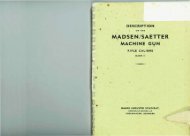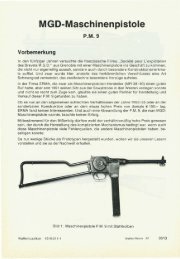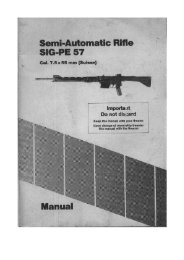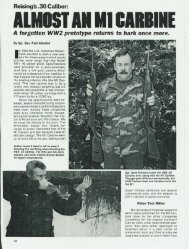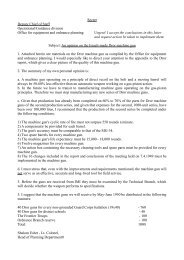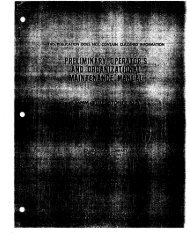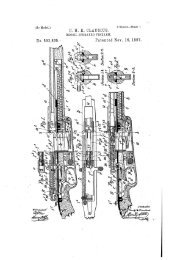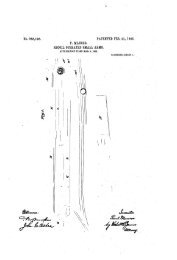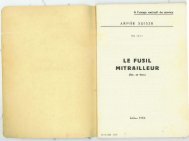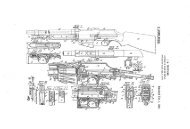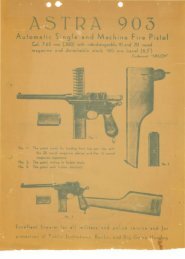Ross Rifle 1907 Manual.pdf - Replica Plans and Blueprints
Ross Rifle 1907 Manual.pdf - Replica Plans and Blueprints
Ross Rifle 1907 Manual.pdf - Replica Plans and Blueprints
You also want an ePaper? Increase the reach of your titles
YUMPU automatically turns print PDFs into web optimized ePapers that Google loves.
26<br />
moval of the pressure the sight leaf spring will reassert itself <strong>and</strong> bring<br />
the rear sight leaf back to its former position.<br />
At the rear end of the rear sight leaf is a wind gauge with a V notch cut<br />
on its upper edge <strong>and</strong> capable of lateral adjustment by means of a screw<br />
with a milled collar.<br />
A scale is marked on the rear sight leaf, each division of which represents<br />
roughly 4 inches per 100 yards.<br />
A thin wire spring is inserted under the curved rear end of the rear<br />
sight leaf with its point protruding through the right side so as to form a<br />
ratchet <strong>and</strong> engage a small recess in the left side of the milled collar.<br />
This can be both felt <strong>and</strong> heard to engage whenever the centre line of<br />
the wind gauge is opposite one of the marks on the scale. It also prevents<br />
the windgauge from slipping from the required position.<br />
To adju..st the sight.-Raise the sight slide by the finger grips until its<br />
teeth are released from the notches of the index slides. Push forward or<br />
draw back the sight slide until the numeral denoting the required range<br />
is wholly visible in rear of the finger grip, release the finger grip, when<br />
the teeth will engage the notches at the required range under the action<br />
of the index slide springs.<br />
To obtain fine adjmt1nrmt.-Revolve the micrometer thimble until the<br />
figm·e denoting the required-adjustment in yards is opposite the centre of<br />
the rear sight leaf.<br />
NoTE.-The fine adjustment is designed to give elevation only <strong>and</strong> not<br />
depression from the different hundred yard graduations on index slides.<br />
It will be noticed that when the micrometer thimble is revolved from left<br />
to right between 0 <strong>and</strong> 95 the index slides will advance, but if the revolution<br />
be continued from 95 to 0 the index slides will return to their normal<br />
position. Consequently if it be desired to give depression fr011L any<br />
hund1·ed yard range the sight must be set at the next lowest hundred yard<br />
range <strong>and</strong> elevation given by means of the micrometer thimble as required.<br />
When firing at 500 yards.<br />
To give 560 yards elevation, revolve the micrometer thimble from left<br />
to right until the figure 60 is opposite the centre of the rear sight leaf.<br />
To reduce this to 530 yards elevation revolve the micrometer thimble<br />
from right to left until the line representing 30 yards is opposite the centre<br />
of the rear sight leaf.<br />
To reduce this to 480 yards elevation, set the sight slide at 400 yards<br />
<strong>and</strong> revolve the micrometer thimble from left to right until the figure 80<br />
is opposite the centre of the rear sight leaf.<br />
To increase this to 500 yards, set the sight slide at 500 yards <strong>and</strong> revolve<br />
the micrometer thimble either way until the figure 0 is opposite the centre<br />
of the rear sight leaf.<br />
To STRIP THE MARK III. SIGHT.<br />
1. Set the sight at 1,000 yards with the micrometer thimble at zero<br />
<strong>and</strong> measure the height of the sight above the barrel. (See Para. 42 in<br />
Assembling the Mark III. sight.)<br />
27<br />
2. Set the sight to lowest range.<br />
3. Unscrew the set screw from micrometer thimble.<br />
4. Hold the micrometer cams from turning with a small screw driver<br />
or other pointed instrument inserted from the rear under the micrometer<br />
thimble into a notch cut for the purpose on the right micrometer cam<br />
<strong>and</strong> screw off the micrometer thimble.<br />
5. Loosen the screw in the sight leaf base.<br />
6. Drive the sight leaf base forward from the underside sufficiently to<br />
withdraw the index slides from the sight base ring.<br />
7. Raising the finger grips slip the sight slide off the rear ends of the<br />
index slides.<br />
8. Remove the index slides <strong>and</strong> index slide springs.<br />
9. Start the sight axis pin with a drift from the right side (about T 1 ll" of<br />
an inch).<br />
10. Using a screw driver or small pointed tool press the right coil of<br />
the sight leaf spring towards the right <strong>and</strong> out of the groove in the sight<br />
axis pin.<br />
11. Finish driving out the sight axis pin from the right.<br />
12. Remove the sight leaf <strong>and</strong> sight leaf spring.<br />
13. Remove sight slide springs from the sight slide.<br />
14. Screw the windgauge to the right as far as it will go.<br />
15. If necessary for repair (not otherwise) hold the milled collar of the<br />
windgauge screw in a vice <strong>and</strong> with a small punch drive the windgauge<br />
screw out of the milled collar.<br />
16. Unscrew the windgauge screw from the windgauge.<br />
17. Remove the ratchet spring from the rear sight leaf prizing it out<br />
of the seating under the rear end of the rear sight leaf.<br />
18. If necessary for repair (not otherwise) prize out the two dowel pins<br />
which secure the sight base ring to the barrel, inserting a screw driver<br />
or other tool to lever them up by the notches which will be found cut on<br />
them.<br />
To AssEMBLE THE MARK III. SIGHT.<br />
19. If stripped for repair, secure the sight base ring by the two dowel<br />
pins which must be flush with the outer circumference of the sight base<br />
ring.<br />
20. Replace ratchet spring in rear sight leaf, entering the point of its<br />
short arm in the small hole drilled in the right h<strong>and</strong> side of the rear sight<br />
leaf, <strong>and</strong> prizing the long arm of the spring into its seating under the rear<br />
end of the rear sight leaf.<br />
21. Place the windgauge in position on the rear sight leaf <strong>and</strong> screw<br />
home the windgauge screw from the left.<br />
22. Bring the windgauge to its central position, taking care that the<br />
head of the windgauge screw is right up against the side of the rear sight<br />
leaf.<br />
23. Start the milled collar on to the end of the windgauge screw in<br />
such a position that the recess on its inner side shall be directly opposite<br />
the protruding end of the ratchet spring.<br />
24. Drive the milled collar on to the windgauge screw in such a position<br />
that the recess in the milled collar engages the point of the ratchet spring<br />
while the windgauge is central.




